#Marie-Anne Charlotte de Corday d'Armont
Text

Charlotte Corday (1793) by Jean-Jacques Hauer
She requested this painting a few hours before her execution.
#Charlotte Corday#1793#1790s#Jean-Jacques Hauer#Marat#Jean-Paul Marat#French Revolution#painting#art#Miss Cromwell#Marie-Anne Charlotte de Corday d'Armont
8 notes
·
View notes
Text

From left to right: Marie-Anne Pierrette Paulze, Élisabeth Vigée Le Brun, Germaine de Staël, Madame Marie-Jeanne 'Manon' Roland de la Platière, Marie-Anne Charlotte de Corday d'Armont, Olympe de Gouges
In 2022 opera on the women of the French revolution premiered! It is called GIRONDINES! It's an English language opera that premiered with Wilmington Concert Opera and will be having its West Coast premier with Mission Opera!

Album image for the original concert cast album
According to an February 2023 article by Broadway World: "The Original Wilmington Concert Opera Cast Album is now available! It features Kirsten C. Kunkle as Charlotte Corday, Ashley Becker as Olympe de Gouges, Marisa Robinson as Marie Anne Pierrette Paulze Lavoisier, Alyssa Maria Lehman as Manon Roland, Raffaella Lo Castro as Germaine de Staël, Tracy Sturgis as Élisabeth Louise Vigée Le Brun, Thuy Nguyen on Violin, Melissa Brun on Cello, and Sarah Van Sciver on Piano."
I have not yet listened but as someone into frev and opera I am very excited. It also looks like the original concert production may be available to watch on YouTube!

Promo image for the October production
So far it looks like these have been small scale productions, but everything starts somewhere! I need to listen to the music but I wish good things to come
#opera#frev#french revolution#history#Marie-Anne Pierrette Paulze#Countess vom Rumford#Élisabeth Vigée Le Brun#Le Brun#Germaine de Staël#Madame de Staël#de Staël#Marie-Jeanne 'Manon' Roland de la Platière#Madame Roland#Marie-Anne Charlotte de Corday d'Armont#Charlotte Corday#Olympe de Gouges#womens history#herstory#new opera#new theatre#theatre#undescribed#please if anyone has the ability to add image ids for this id appreciate it
9 notes
·
View notes
Photo
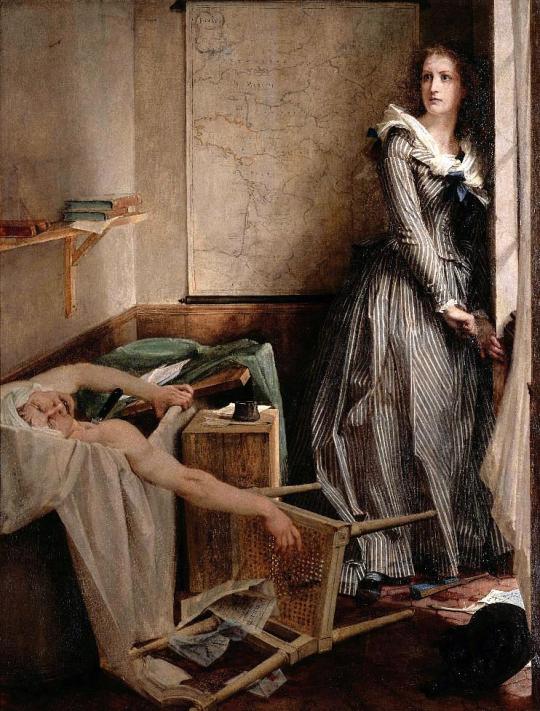
MWW Artwork of the Day (7/15/22)
Paul-Jacques-Aimé Baudry (French, 1828–1886)
Charlotte Corday (The Assassination of Marat)(1860)
Oil on canvas, 203 x 154 cm.
Musée d'Arts, Nantes
Marie-Anne Charlotte de Corday d'Armont (1768–1793), known as Charlotte Corday, was a figure of the French Revolution. In 1793, she was executed by guillotine for the assassination of Jacobin leader Jean-Paul Marat, who was in part responsible for the more radical course the Revolution had taken through his role as a politician and journalist. Marat had played a substantial role in the political purge of the Girondins, with whom Corday sympathized. His murder was depicted in the painting "The Death of Marat" by Jacques-Louis David, which shows Marat's dead body after Corday had stabbed him in his medicinal bath. In 1847, writer Alphonse de Lamartine gave Corday the posthumous nickname "l'ange de l'assassinat" (the Angel of Assassination).
#paul-jacques-aimé baudry#charlotte corday#the assassination of marat#french artist#history painting
15 notes
·
View notes
Photo

Got the itch to just subtly animate this one. Charlotte Corday lives!
#Charlotte Corday#French History#French Revolution#révolution française#gif#animation#paper craft#cut paper#paper art#Marie-Anne Charlotte de Corday d'Armont#historical illustration#assassin#women#women's history
6 notes
·
View notes
Note
charlotte corday is a weird girl

Marie-Anne Charlotte de Corday d'Armont from Real Life is a weird girl!
19 notes
·
View notes
Note
Marie-Anne Charlotte de Corday d'Armont (27 July 1768 – 17 July 1793), known as Charlotte Corday (French: [kɔʁdɛ]), was a figure of the French Revolution. In 1793, she was executed by guillotine for the assassination of Jacobin leader Jean-Paul Marat, who was in part responsible for the more radical course the Revolution had taken through his role as a politician and journalist.[1] Marat had played a substantial role in the political purge of the Girondins, with whom Corday sympathized.
Ah.
3 notes
·
View notes
Text
Charlotte Corday

Charlotte Corday (c. 1860), Musée des Beaux-Arts de Nantes
“Marie-Anne Charlotte de Corday d'Armont (27 July 1768 – 17 July 1793), known as Charlotte Corday, was a figure of the French Revolution. In 1793, she was executed by guillotine for the assassination of Jacobin leader Jean-Paul Marat, who was in part responsible for the more radical course the Revolution had taken through his role as a politician and journalist. Marat had played a substantial role in the political purge of the Girondins, with whom Corday sympathized. His murder was depicted in the painting The Death of Marat by Jacques-Louis David, which shows Marat's dead body after Corday had stabbed him in his medicinal bath. In 1847, writer Alphonse de Lamartine gave Corday the posthumous nickname l'ange de l'assassinat (the Angel of Assassination). ...”
Wikipedia
“David, Not a Feminist”: Paintings Depicting Charlotte Corday’s Assassination of Marat
YouTube: Charlotte Corday and the Death of Marat (Women and the French Revolution: Part 5)
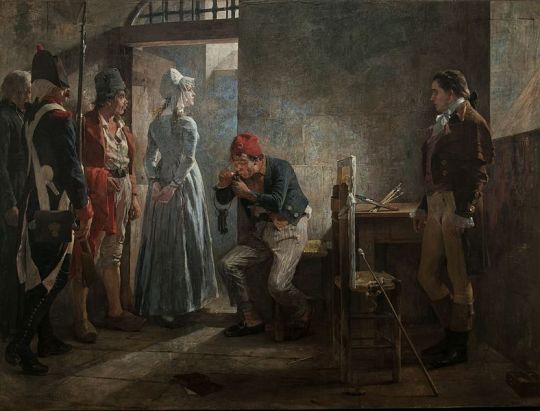
Charlotte Corday being conducted to her execution, by Arturo Michelena (1889); the warden carries the red blouse worn by Corday and the painter Hauer stands at the right.
2014 February: French Revolution Digital Archive, 2015 July: A Guide to the French Revolution, 2016 April: Vigée Le Brun: Woman Artist in Revolutionary France, 2017 March: Paris Commune 1871, 2018 February: Flash Mob: Revolution, Lightning, and the People’s Will, 2020 February: The French Rural Revolution 1789-1793, 2021 June: Sans-culottes
1 note
·
View note
Text
5 Deadly Women in History
To promote the release of Donnell Keenan’s comic book The Women of the Red Bonnet Society, we’ve made a list of history’s most deadly women. Like Malia Papov of Keenan’s Red Bonnet Society, these assassins have earned their place in world history as ruthless and cunning women who took things into their own hands.
1. Charlotte Corday
Born Marie-Anne Charlotte de Corday d'Armont in 1768, Charlotte became a prominent figure of the French Revolution. Jean-Paul Marat, her victim, was a member of the radical Jacobin faction that had a leading role during the “Reign of Terror” in France. As a journalist, he wielded power and influence through his newspaper, L'Ami du people or "The Friend of the People".Corday's decision to kill Marat was stimulated not only by her revulsion at the September Massacres, for which she held Marat responsible, but by her fear of an all-out civil war. She murdered him during his medicinal bath for his skin condition, which he was known to conduct business often from. At the age of 24, she was sent to the guillotine.
2. Marie Sukloff
In 1914, a peasant, Marie Sukloff, joined an organization that we would term terrorist today and was on her way to infamy. At the turn of the 20th century, Tsarist Russia was disintegrating from within, thanks to severe poverty, underground movements against the social injustices of the time and the immorality that preceded power throughout the empire. Armed with a bomb that she chucked through the front window of his carriage, she assassinated Russian Governor General Fyodor Dubasov, a governor who was notorious for carrying out pogroms on local Jewish families.
3. Kim Hyon-hui
I love that this murderer officially identifies herself as an “agent”. Having gone by the names Ok Hwa and Mayumi Hachiya, she is known for the bombing of Korean air flight 858 in 1987. Kim spent several years learning spycraft before her crime. Of which, she was sentenced to death. But, interestingly enough, was pardoned for.
4. Brigitte Mohnhaupt
Known as a one-time leader of Germany’s Red Army Faction, Brigitte is said to have killed over 30 people from 1971 to 1982. Her resume includes some high rank espionage and some really badass weaponry. Including tanks, rocket launchers, and bazookas. Upon her arrest, she was linked to these murders, but since no proof could be applied, she was given under thirty years in prison. She was released and paroled in 2007, which caused many to uproar in backlash.
5. La Tigresa
Nicknamed that for her “sexual prowess”, Idoia Lopez Riano is one of the fiercest known female assassins. For the last several decades, the Spanish government has had its hands full fighting a separatist conflict in the country's Basque region against Eta, a terrorist group that has killed over 800 people since 1970. The blood from at least 23 of those dead are on the hands of ETA's most notorious female assassin, Riano (aka La Tigresa), who The Guardian referred to as "a green-eyed, glamorous gun woman who police, journalists and some repentant former companions have painted as a man-eating, man-murdering monster." Currently La Tigresa is serving a 30-year prison sentence.
2 notes
·
View notes
Photo

『God has always been hard on the poor.』 . 5月24日知名壽星:『死了比活著更有名』的 馬拉(Jean-Paul #Marat,1743-1793) . 誕生於昔日普魯士王國布德里(#Boudry,今瑞士境內),馬拉最早是在法國巴黎修習醫學,雖然沒有取得正式執照,但後來依舊在英國倫敦『懸壺濟世』過一段時間,並結識了不少藝術界與政治圈的朋友,同時開始發表有關社會現象、哲學思想,進而是科學實證的論述,多才多藝,逐漸在英法兩地贏得名聲…當時他還未滿35歲。 . 作為西元十八世紀法國大革命期間,巴黎當地最著名的激進派政治活動家與評論家代表,馬拉在踏入政壇之際,其實將自己定位在科學家和醫師之間,然火熱與激進的思維,讓他不只早先公開發表『奴隸制枷鎖』(Chains of Slavery),反對英國式的君主立憲制外,更認為本意良善、追求穩定與和平的『人權宣言』,充其量只是普羅大眾、貧窮百姓的春藥與安慰劑! . 因為在馬拉的心中,面對如此動盪的世道,看見那欺壓弱勢的既得利益者,在耶穌基督再來之前,他全然不相信什麼和解或寬容,唯有強烈主張以暴力反制權貴,才是人民革命行動中,必要且專一之措施! . 為此,就在法國人民齊心攻破『巴士底監獄』的黑牢,粉碎法皇路易十六的貪腐政權短短四年之後,創辦『人民之友』(L'Ami du peuple)報刊,嚴詞抨擊後繼當權者軟弱的馬拉,和其他遭到排擠之激進派盟友,終於在西元1793年的5月,逮到機會再一次發動武裝政變,推翻了屬性傾向溫和的共和主義派,強勢建構起意圖消滅任何反動勢力的恐怖政治集團。 . 但由於馬拉過於偏激的立場,讓他前幾年不停受到政敵打壓,被迫暗自窩在地窖(有一說是巴黎下水道)裡處理公務,避免仇家叨擾,結果卻也使得他不幸了染上嚴重的皮膚病(類似濕疹),付出慘痛代價,成天只得泡在藥草堆滿的浴缸,邊工作邊療養,對外繼續發號施令、鏟除異己。 . 就在…西元1793年的7月13日,一位來自於諾曼第沒落貴族世家的美女,名叫夏綠蒂.科黛(Marie-Anne Charlotte Corday d'Armont,1768-1793),她在就讀修道院期間,接觸了有關自由、博愛的思想,進而力挺堅持革命理想的共和派,反對一切都訴諸暴力的激進思維,所以當共和主義派議員受到馬拉等極端激進派驅逐,整個法國社會亦陷入了空前政治的危機之際,她自願加入了暗殺敢死隊行列,並在這一天,親自進入了馬拉的寓所,假藉著手上握有共和派意圖發動政變的第一手資料,在馬拉卸下心防的當下,科黛於浴缸旁,無聲無息,利刃一刀刺入了他的胸口! . 馬拉,不知道有無哀號,抑或是抵抗…一命嗚呼,終年50歲。 . 萬般戲劇化,慘遭刺客暗算的魂斷人亡,也讓同屬激進派的好友,名畫家大衛(Jacques-Louis #David,1748-1825)感嘆不已,悲壯地完成日後成為經典的『馬拉之死』(La Mort de Marat / The Death of Marat)。 . 馬拉的死,讓激進派找到了更多鎮壓共和派人士的理由,以暴制暴成為家常便飯,而為了突顯馬拉為『真理』犧牲的偉大,激進派當局也隨即將馬拉『神格化』,用革命殉道者的身分列入巴黎『先賢祠』(#Panthéon)當中,與伏爾泰並存,期盼能供後人永遠敬仰與膜拜… . 『No, liberty is not made for us...』 . 可是這風水輪流轉,才過了一年,激進派政權無法無天的濫殺無辜,惹來民怨,竟又遭到了共和派支持者的推翻,馬拉的遺骨,此刻不再是神話,反而變成了笑話,自然也被請出了先賢祠。 . 終曲:附帶一提,如果好友們想要現場欣賞『馬拉之死』這幅畫作的話,那要請您前往位在比利時布魯塞爾的『皇家美術博物館』(Musées royaux des beaux-arts de Belgique)。 . 尾聲:對了,第三張附圖,是另外一張『馬拉之死』,呃,很像塗鴉嗎?不是小編畫的哦!誰?你問我?路人甲? . 哈哈...畢卡索!#history #birthday #may #swiss #france #revolution #painting #man #time #assault #death #politics #picasso https://www.instagram.com/p/BxzU8P_Hip9/?igshid=1d0gpyebqk4m7
#marat#boudry#david#panthéon#history#birthday#may#swiss#france#revolution#painting#man#time#assault#death#politics#picasso
0 notes
Text
Jean-Paul Marat & Charlotte Corday
Word Count: 779
Additional References
Out of everything that has been discussed and read in these past two class periods, nothing has struck my interest more than Jean-Paul Marat. A man of radical values and well ahead of his time, Marat had preceded Karl Marx by almost a century (though I find myself wondering just how to two would have interacted had they been born in the same lifetime) and many people found his ideas to be quite extreme. One of my favorite examples of this is when the Jacobins were debating on what should be included in the new French constitution, Marat argued that the “right of man ‘to deal with their oppressors by devouring their palpitating hearts’ be asserted in it” (Hampton Institute). Of course, this in turn brings up a question of morality: is it okay to harm or kill one’s own oppressor? The Declaration of the Rights of Man promises the rights of liberty, property, security, and resistance to oppression, but how far does resistance go? They would have agreed with Marat to a point, but questions of morality seldom ever have a unified answer--even today, we’re still asking ourselves if it’s okay to punch a Nazi. But Marat was known as the People’s Friend and the epitome of liberty, and the people of France were in the middle of a multi-sided revolution. It is no wonder then, that, when Marat’s assassination was followed by the execution of Jacques Hebert, Georges Danton and Camille Desmoulin, Robespierre lost control and the Thermidorian Reaction took place.
The fact that there was little solidarity only lead to further bloodshed and death as extremists on every side had the “kill all who are not on your side” mindset. When Marat was first assassinated, he was seen as a Martyr for the people, which in turn set the revolution even further into motion. Looking back on events like this, it’s easy to see how much one person can affect history--though, in this case, that one person could be considered Charlotte Corday. Marie-Anne Charlotte de Corday d'Armont, perhaps much like many other Girondins, saw Marat as the biggest threat in Paris, as he was “the very embodiment of French radicalism.” After witnessing first-hand the exiled Girondins, and perhaps even before that, her intense hatred for Marat had lead her to leave Normandy and seek after him. She was not unknown to the consequences of her actions, and one source even goes as far as to state that she wrote farewell letters to loved ones and paid off all her debts before leaving for Paris. After the murder, many people had (unsurprisingly) judged her specifically on her sex. Just as T.J. Clark quotes Citizen Shade in saying that Corday was “vomited from the jaws of hell to despair both sexes,” and therefore “belong[ed] directly to neither.” It was a time where women were still seen as timid and nurturing, unable to commit such dastardly acts--a gendered stereotype that would affect the revolution as time went on. According to the UCL Art Museum’s website, pictures of Corday spread throughout Paris:
“In the months following Charlotte Corday’s execution for the murder of Marat, images of her that stressed her beauty, virtue and stoicism began to appear in the moderate press. These constructed her as a saviour who had rid the nation of a terrible monster. Such images were unequivocally denounced by followers of Marat who, fearful of a cult forming around Corday, wanted the memory of her consigned to oblivion.”
This would be an instance where art itself was impacted by politics. Corday’s portrait became popular, specifically made to point out her soft face with rosy cheeks, her young and nurturing body, as well as the curls of her hair and the warmth in her eyes. As Marat was became a monster months after his death, so Corday became the beautiful, young hero of France, both used as nothing more than pawns in French politics to sway the public one way or another. Of course, though they are dead and long gone of this world, they were remembered by the people they inspired, the ones they were hated by, and the politicians that used their deaths for their own gain. We learn of Jacques-Louis David’s painting Death of Marat, and how he portrayed Marat a Jesus in attempt to make the people of his time see Marat as a savior himself. But I believe it should also be noted that, many years later, Paul-Jacques-Aime Baudry creates his only known historical piece. It is called Charlotte Corday after the murder of Marat in 1860--and, much like the portraits after her execution, she portrayed as young, beautiful, and innocent.
1 note
·
View note
Photo
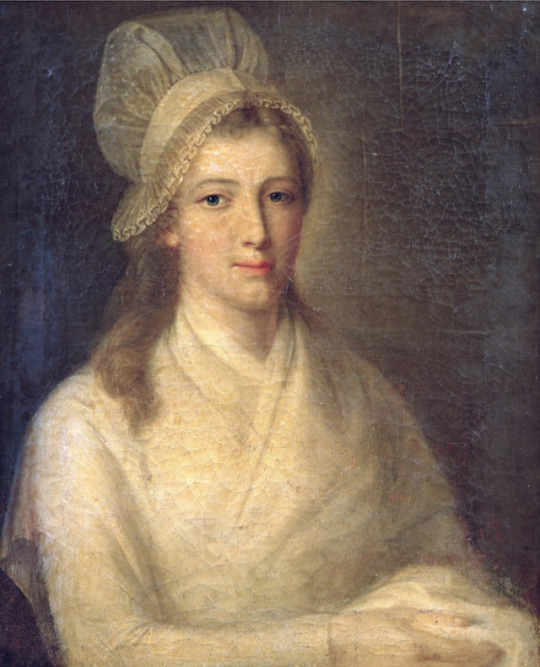
Charlotte Corday (27 July 1768 - 17 July 1793)
#charlotte corday#marie-anne charlotte de corday d'armont#daughter of jacques françois de corday seigneur d'armont#history#women in history#18th century#art
0 notes
Photo
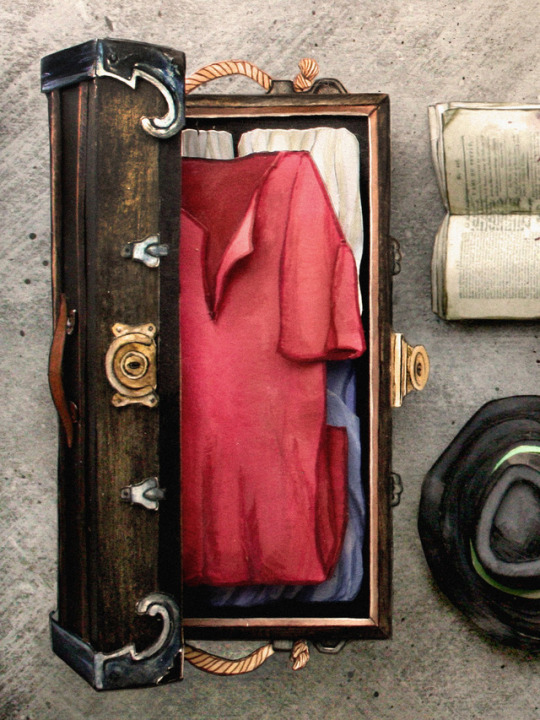
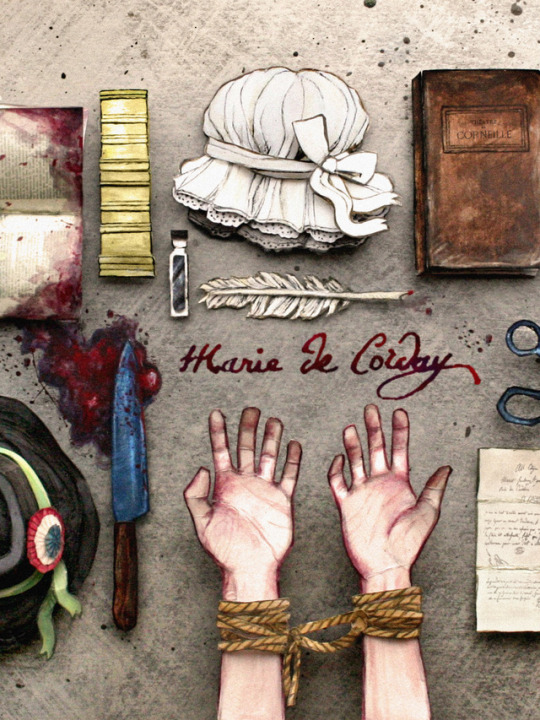

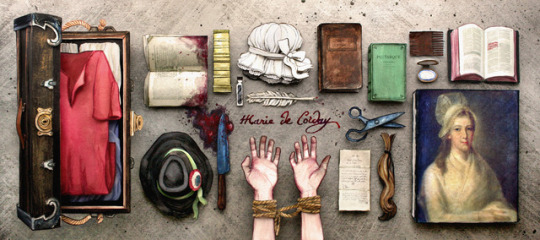
I’ve been getting my hands dirty with everything Révolution Française recently, and trying to decide how to best capture some of the characters in this fascinating, volatile, and fervently debated time in our history.
So. In steps Marie-Anne Charlotte de Corday d'Armont. Just your typical, small town girl from a impoverished aristocratic family, who one day packed up her trunk, left for Paris, and tracked down voice of the Revolution, journalist Jean-Paul Marat, and... stabbed him to death in his bath at his home. The whole story is bonkers, which kind of explains why so many artists are obsessed with painting it, and why each depiction has a conflicting narrative.
I could go on about it forever: How Corday didn’t tell anyone of her plan before she up and left. How she serenely wrote letters to her father from jail. How she politely persisted to have her portrait painted before her death. The way the press speculated over who the male mastermind behind her crime was. And then... how the public dealt with the aftermath. Marat became a martyr, despite it all-- I mean, they embalmed the dude’s heart and hung it up as festive decor at the Cordelier Club.
So, if you want more details: paper piece by piece, here they are. A brief look into Corday’s life, as depicted through her belongings upon execution.
1:
Corday's traveling trunk-- Inside is the red blouse she would wear to her execution by guillotine- a symbol of a traitor to the revolution who had assassinated a representative of the people.
2:
A copy of Marat's newspaper L'Ami du people, soaked in his blood. No artistic license here, that stained paper has survived since 1793.
A penner- a traveling writing case that would contain ink and a quill.
The "corday" or mob cap that Corday made for herself after her arrest. She is depicted wearing the same cap in the portrait she sat for 3 hours before her execution.
A collection of dramatist Pierre Cornell's plays of which Corday was both a fan and a 5th generation decendent.
The letter Corday wrote to Marat seeking an audience with him.
The 6 inch kitchen knife Corday purchased in Paris.
The fashionable hat most media depicted Corday wearing when she stabbed Marat, adorned with the revolutionary cockade pin.
And Corday's signature-- pulled from her surviving letters.
3:
The copy of Plutarch's Parellel Lives which Corday brought to Paris with her.
A wooden comb and a patch box filled with powder.
The (alleged) open Bible found in her hotel room, with the passage of Judith's beheading of Holofernes underlined.
The portrait Corday paid to be painted of herself while she waited for her execution in the Conciergerie.
And a cut piece of her hair, which she gave to the artist Jean-Jacques Hauer as payment. (Also, her hair would also have been cut to avoid being caught in the guillotine. Yikes.)
So that’s it for Mademoiselle Corday! I really would love to do more of these “what’s in my bag” historical style illustrations. I just want people to be excited about history with me guys!
#Charlotte Corday#history#french history#french revolution#paper craft#cut paper#paper art#faye rogers#aritsts on tumblr#illustators on tumblr#illustration#historical illustration#history buff
19 notes
·
View notes